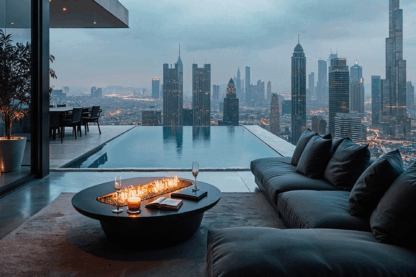What does luxury mean when anyone can book the suite, buy the watch, and fly first class? As affluence expands across generations and continents, the traditional codes of luxury travel are being challenged. The 2024 report, Evolving Wealth: A New Paradigm for Luxury Travel by WATG Research, examines these shifts by exploring consumer behavior, demographic transitions, and regional economic growth. Rather than focusing solely on exclusivity, the new affluent traveler seeks value in meaningful experiences, emotional connections, and environmental responsibility.
The report offers a comprehensive view of the present and future of high-end travel, outlining how design, destination development, and service expectations must evolve to meet the tastes of a younger, globally mobile clientele. With the global luxury market surpassing USD 1.54 trillion and $219 billion accounted for by luxury hospitality alone, the stakes for the industry are high. This document is both an analytical overview and a strategic foundation for those looking to engage with the future of wealth-driven travel.
In this report summary, the World Luxury Chamber of Commerce highlights key insights into the global luxury travel sector in 2025.
A Demographic Overview
The luxury hospitality sector has recovered strongly in the post-pandemic era, fueled by a change in consumer preferences away from possessions and toward experience. This shift is particularly prominent among Gen Z and Millennial high-net-worth individuals (HNWIs), who now favor immersion, purpose, and authenticity. These generations are already commanding a larger share of discretionary wealth, supported by a historic USD 84 trillion intergenerational transfer set to occur in the United States by 2045.
Unlike older demographics, these consumers do not view luxury as static. Instead, they treat it as dynamic, a set of conditions shaped by sustainability, digital convenience, and access to culture. For instance, over 38% of luxury travelers report a willingness to pay 30–50% more for environmentally conscious accommodations and services. This preference is not a marketing trend but a shift in expectations. Properties and destinations must reflect these values in meaningful ways, rather than symbolic gestures or surface-level features.
While generational change plays a defining role, the range of affluent travelers today is broader and more complex than ever before. WATG outlines four distinct segments. The Mass Affluent earn between $100,000 & $1 million in assets and represent a large, globally influential group. They tend to be value-focused but consistently prioritize travel, wellness, and education. Millionaires Next Door, with assets between $1 million and $5 million, prefer understated luxury and tend to seek quality over visibility. HNWIs, with a wealth of $5 million to $30 million, form a core group of high-end hospitality consumers and are particularly active in Asia, North America, and the Middle East. Finally, Ultra-HNWIs, representing individuals with more than $30 million in net worth, have particular preferences: privacy, personalization, and rare experiences are central to their expectations.
The Focus Placed on Experiences
Across all these groups, a common theme emerges: experience has overtaken material goods in importance. In the United States, spending on experiences has grown steadily since the 1960s, while spending on physical goods has declined as a proportion of discretionary income. Millennials, who currently take an average of 35 vacation days per year, and Gen Z travelers, who average 29, place a premium on international, culturally immersive trips. These younger travelers are shaping demand for accommodations that serve as platforms for personal growth, whether through nature, history, art, or wellness.
The design priorities of luxury travel providers are shifting accordingly. Properties that once relied on standardized luxury services must now respond to demands for ecological integrity, digital adaptability, and spatial flexibility. Many travelers in these segments now identify as “global citizens,” maintaining homes in multiple countries and expecting a consistent, high-quality experience wherever they go. They increasingly work remotely, travel more often for leisure than business, and seek accommodations that allow them to blur the line between productivity and rest.
Brand loyalty, once rooted in prestige, is now earned through authenticity, purpose, and performance. High-net-worth Millennials and Gen Z travelers are more likely to book extended stays, seek out unique architectural or cultural experiences, and choose hospitality providers that align with their social and environmental values. Space tourism, artist residencies, eco-conservation, and off-the-grid retreats are no longer niche concepts; they are fast becoming essential offerings in this competitive segment.

Regional Trends: Where the Money’s Going
- North America continues to lead in total HNWI population and wealth. New York, Los Angeles, and Chicago are top growth markets, with New York alone showing luxury hotel demand 337% above the national average.
- Asia-Pacific is witnessing accelerated growth. India’s affluent population is expected to grow from 60 million to 100 million by 2027. China, despite recent slowdowns in wealth growth, remains a dominant force. Southeast Asia (notably Vietnam, Thailand, and the Philippines) is quickly becoming a key source of outbound luxury travel.
- The Middle East is forecast to experience a 150% increase in centi-millionaires by 2028, with Dubai, Riyadh, and Doha leading development and luxury spending. A growing number of global brands are focusing on expansion strategies here.
- Europe remains a strong and stable source of affluent travelers. Germany leads in HNWI population, while cities like London and Prague are seeing above-average demand for luxury accommodations.
- Latin America and Africa show more modest near-term growth, but with rising middle- and mass-affluent populations, these markets present longer-term opportunities. Mexico, Brazil, and South Africa are notable markets to watch.
As Millennials and Gen Z shape both the demand and the discourse, travel providers must reframe their offerings to appeal to a consumer base that is more environmentally aware, digitally integrated, and globally connected.
The geographic landscape of wealth is also changing. With new affluence emerging in India, Southeast Asia, and the Middle East, brands must plan not only where they operate but also how they engage with diverse cultural expectations and behavior. Sustainability is no longer optional. The future will favor those who can listen closely, adapt intelligently, and deliver travel experiences that are desirable and relevant.
To read the full report by WATG, visit: https://www.watg.com/affluent-travel-trends-2025/
Stay up to date on the latest luxury industry news: https://worldluxurychamber.com/insights-news/





